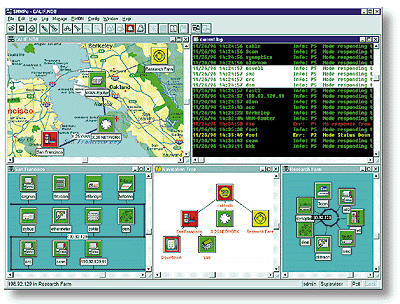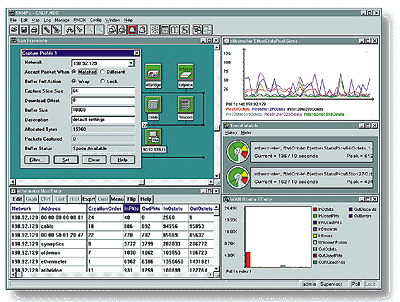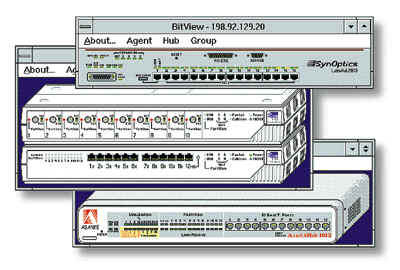SNMPc 4.0 Network Manager
Key Product Features
|
Workgroup Overview
SNMPc is an affordable SNMP based network management platform for Microsoft Windows. It is ideally suited for general monitoring and management of small to medium sized networks, or as a configuration tool for hubs, bridges and routers.
Use SNMPc to diagram your network topology, depicting different device types with built-in or user-defined icons. Alternatively, SNMPc can automatically detect devices and create a network map, selecting icon types based on device queries.
SNMPc polls devices at user defined intervals and displays the status with different colors. Status changes and received traps are written to a log file, which can be selectively viewed or printed. You can also create event filters to perform custom actions when a matching event occurs.
SNMPc insulates you from the complexities of manipulating MIB groups and tables. After selecting a structured MIB object, any function can be performed with a single mouse click. You can also define custom menu options that execute any commands.
SNMPc application programs are included for graphical display of devices and detailed management of private MIBs. SNMPc also integrates with HP OpenView/Windows to run any SNMPc function from the OpenView console.
SNMPc supports a multi-level hierarchical map. Each hierarchy can represent countries, cities, buildings, or computer rooms. Imported bitmaps of geographic maps or floor plans, along with manual or automatic network placement, lets you create a layout that closely matches the actual network.

Node Discovery automatically creates a network topology. Each IP or IPX network is assigned an SNMPc hierarchy node, and agent devices are placed at the lowest level. SNMPc uses a variety of methods to discover nodes, including IP/IPX/SNMP broadcast requests, IPX/RIP and routing table lookups, and sequential address sweeps.
The SNMPc Navigation tree displays your network map as a tree. The status of devices in each hierarchy is displayed on the Navigation Tree so you can quickly see where failing nodes reside. Double clicking on any icon opens and displays the related hierarchy.
SNMPc changes the color of map objects based on the results of polls. You can set the polling variables for node and port status to any MIB variables. Threshold values can be set for any variable to generate an event when a limit is exceeded. Health meters display the current and peak values of any threshold polling variable.
SNMPc events are prioritized and saved in a log file. Multiple views of the log file are possible, and filters let you selectively display portions of the log file.
Event filters select the action to take when an event occurs. SNMPc can log the event, generate an alarm window, set the map node color, or execute an application program. With the Pager Notification application, SNMPc can send a message to a numeric pager.
The built-in MIB compiler accepts any MIB in ASN.1 format. Many standard and Enterprise Specific MIB's are pre-installed and ready to use. Once compiled, MIB definitions can be used by any SNMPc MIB commands. Trap definitions are also available for selecting event filters.

The Display MIB Table command shows an entire MIB table in a multi-column window. You can select an entry from the displayed table to perform other SNMPc commands. The Edit command can delete or modify an existing table entry, or add a new entry. An entry can also be selected for real-time display as a graph, chart, or list window.
The MIB browser lets you perform low level SNMP Get, Get Next, and Set commands on individual MIB variables. You can select MIB variables by using a tree structured MIB directory, or use the Repeat option to display all variables supported by a device.
User defined menus directly perform SNMPc commands without having to select a table or table entry. Custom menus can display a MIB table; edit, chart, graph, or list a MIB table entry; set an SNMP MIB variable; or run an application program. SNMPc supports a complete Application Programming Interface using Windows Dynamic Data Exchange. Sample API program source code is included. Application programs can be started when you double click on a node icon or when a user-specified event occurs. You can also use existing applications, such as Microsoft Excel, to get information from SNMPc.
The HubView and BitView scripting applications display a graphical image for multi-slot routers, bridges, and hubs. HubView and BitView display ports using different icon types, and LEDs show port activity and status. Device specific custom menus and mouse commands perform SNMPc NT commands on the currently selected slot or port, or other graphical element.

TrendView saves and displays historical information as graphs, pie, or bar charts. You can easily find peaks and other interesting traffic patterns in graphs, and then zoom in for a more detailed view. Pies and charts show statistic totals during specified intervals. Saved data can be exported to CSV or TSV format files for import into popular applications such as Microsoft Excel.
SNMPc includes support for any RMON probe. All aspects of a probe can be easily configured. Histories can be downloaded and viewed as graphs, pies, or charts. Host conversations are displayed in a matrix graph. High level packet capture filtersare based on protocol or application type and source destination addresses. Captured packets are saved to disk in industry standard formats.
![]()
Download a demo copy of SNMPc Workgroup |
Press here to request further information | Return to home page